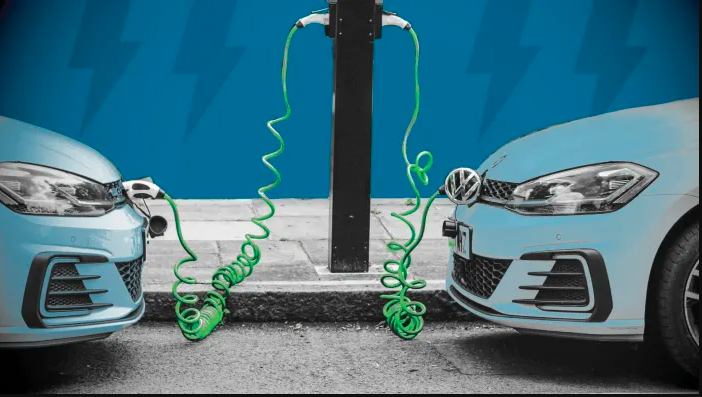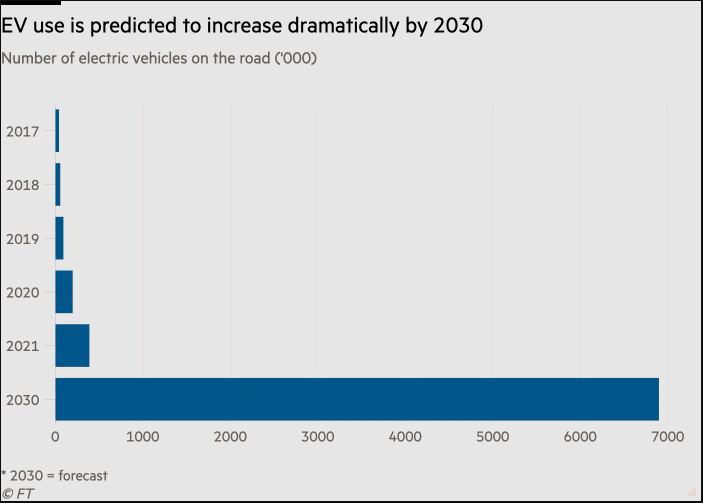Government infrastructure strategy aims to unblock rollout bottlenecks

The pavements of the UK have become a battleground in the fight to shift the country towards electric vehicles.
As battery vehicle sales in Britain outstrip predictions, the industry has voiced alarm that there are not enough public charging points to meet demand.
The UK government has already set aside more than £1bn to help boost the rollout of the charging network. In the coming weeks, it will publish an infrastructure strategy that will set out how Britain can cater to this growing army of electric motorists.
At its heart will be questions about how people will charge their vehicles, and how to address two key bottlenecks in the system: motorway charging services and on-street charging for those without driveways.
The state of the network
The UK currently has one of the world’s highest ratios of public charging points to battery cars, behind only Japan, China and South Korea. The country has about 50,000 public chargers spread across streets, shopping centres, motorway services and other sites such as petrol stations.
The number of EVs is expected to balloon to 7mn by 2030, when the government will phase out the sale of new petrol and diesel models. But the industry has warned that the rollout is not keeping pace.
Electric vehicle numbers rose fourfold to almost 400,000 between 2019 and 2021 but the number of public charge points increased by just 70 per cent in the same period, according to the Society of Motor Manufacturers and Traders.
“This is undermining consumer confidence to make the switch, with range anxiety now replaced by charging anxiety,” warned Mike Hawes, SMMT chief executive.
How many charging points are needed?
There are many, often wildly different, predictions of how many chargers will eventually be needed in the UK and where they should be located. For this reason, the government’s infrastructure strategy is not expected to contain specific “targets” — in spite of calls from the industry to have binding goals.
“Targets will be meaningless,” said one person who advised on the strategy.
There is also a perception challenge: consumers will be reluctant to buy an EV until they can see chargers everywhere, even though they will probably use very few of them, say experts.
“There are two networks; the one people will use, and the one people need to see before they move, and there is very little overlap between the two,” said one person involved in drafting the government strategy.
Why slow chargers are vital
If the vast majority of EV drivers rely on home, on-street or workplace charging, then millions of “slow” chargers that trickle electricity into the car over several hours will be needed.
“Off-street” chargers can be installed by anyone with a driveway. Although a government grant to cover 75 per cent of the installation cost ends next month, installers are struggling to keep pace with demand. Myenergi, which opened a 35,000 square foot facility in Grimsby to manufacture its Zappi chargers, has already had to increase its production space twice.
“We were originally going to build a 45,000 [sq ft] site, but already increased to 60,000 before we even put a spade in the ground,” says co-founder Jordan Brompton. “It’s growing faster than we ever anticipated.”
But the 40 per cent of car owners who do not have a driveway will need access to on-street chargers, where demand already outstrips supply.
Installing on-street chargers is complicated. Local councils must either grant planning permission for each unit, or allow a private company to dig up the road to install cabling. With councils stretched from years of budget cuts and reluctant to take precious parking spaces from car owners, the rollout has been slow.
One model that could scale up installation allows entire streets to be “wired up”, with new chargers put in when needed — similar to the rollout of cable TV or fibre broadband.
Trojan, an Aberdeen-based group, specialises in flush on-street charging points, which owners can plug into with a foot-long “lance” they carry in their car. This avoids the need for dedicated charging bays that deprive non-electric users of parking space. The company is trialling a 150-strong rollout in the London boroughs of Brent and Camden next month, but still needs local planning permission for each installation.
“Everyone knows the problem, and we’re all trying to find ways to make it easier,” said Ian Mackenzie, Trojan chief executive. “If I could choose one thing to solve, it would be the planning constraints.”
Officials agree that the need for local authority approval is the single greatest hurdle to the rollout of nationwide on-street charging network, an issue that was highlighted by MPs in a 2018 report.
The challenges facing fast chargers
Fast chargers, which are situated at some petrol stations or shopping centres, will become more important if on-street charging fails to expand. Provision will also be crucial for longer trips by EV drivers and vital to widespread take-up.
A single fast charger caters for the same number of vehicles as 60 slow ones, according to estimates by BP. However, some sites will need new grid connections to support the demands of high power charging. These can cost millions of pounds if they are located far from the grid’s high-speed transmission system.
“The big problem is you can’t move the motorway service areas,” said one person in government who has been involved in the strategy. A lack of competition between providers to motorway services operators has also hindered the rollout of the high-speed charging network. One company, The Electric Highway Company, had exclusive rights to operate chargers at UK motorway services for the past decade but failed to invest in its equipment.
Gridserve, which is backed by Hitachi, bought the network last year and is in the process of modernising it. Under current rules, every service area must have six fast chargers by next year. This year alone Gridserve plans 30 high-speed charging hubs.
The government’s strategy is likely to call for longer-term planning, even if that means allowing companies to operate for longer to recoup their investments. “The question is, do you play down the monopoly risk to get the infrastructure out there,” says one person who was consulted on the strategy.
How long will it take to build capacity?
The UK auto industry predicts that only one in five cars on the road — or roughly 7m vehicles — will be fully electric by 2030.The SMMT forecast last year that 2.3m chargers are needed to cope with this expected demand.
Even if the eventual number turns out to be much lower, with electric sales increasing every year, changes in the network need to begin happening now.

But officials concede that for EV take-up to continue to grow, especially among homeowners without driveways, the process of building charging infrastructure needs to move much, much faster. “It’s not going to be easy,” says one person who has been involved in designing the strategy. “It’s going to be stressful, and there will be teething problems. But that doesn’t negate the benefits of the technology.”
About Newyea technologhy in China
Newyea technology ' s advantages are affordable prices,dynamic revenue team,specialized QC,sturdy factories,superior quality services for home and commercial.wired and wireless EV charger,.Welcome you to join us together to make your business easier. We are always your best partner when you want to have your own business.
Hot New Products China EV Charger, Home Use AC Charger, Our expert engineering group will always be ready to serve you for consultation and feedback. We've been able to also provide you with absolutely free samples to meet your requirements. Finest efforts will likely be produced to offer you the ideal service and items. For anyone who is thinking about our company and merchandise, you should contact us by sending us emails or contact us quickly. As a way to know our merchandise and firm. lot more, you can come to our factory to find out it. We'll always welcome guests from all over the world to our business to build company relations with us. Please feel free to get in touch with us for business and we believe we have been planning to share the top trading practical experience with all our merchants.